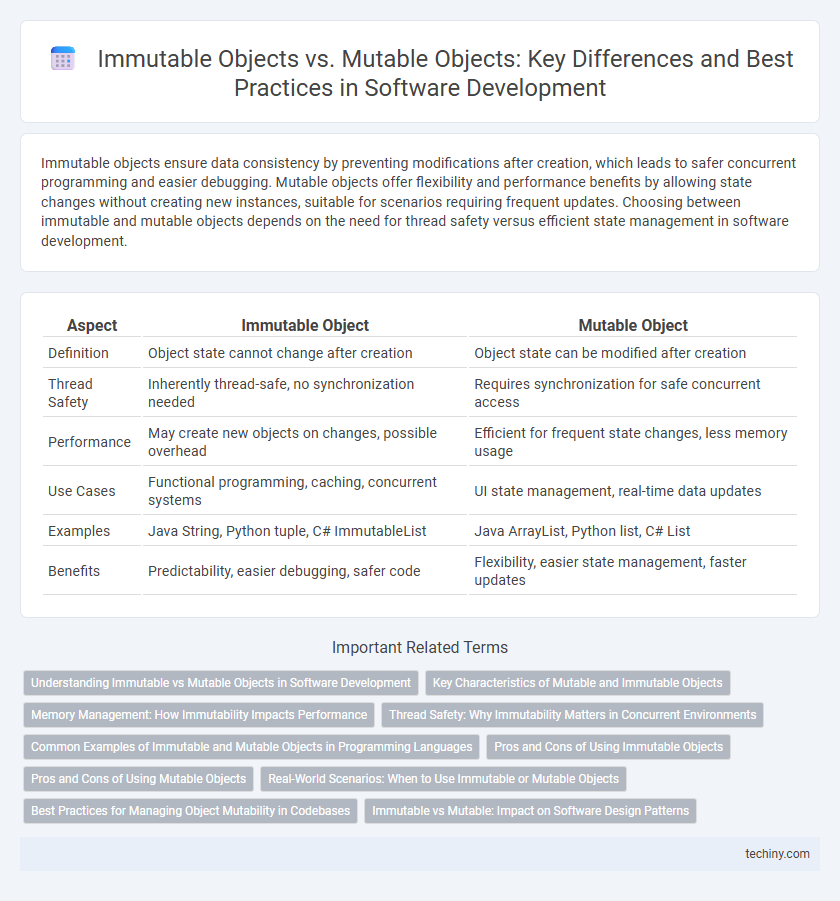Immutable objects ensure data consistency by preventing modifications after creation, which leads to safer concurrent programming and easier debugging. Mutable objects offer flexibility and performance benefits by allowing state changes without creating new instances, suitable for scenarios requiring frequent updates. Choosing between immutable and mutable objects depends on the need for thread safety versus efficient state management in software development.
Table of Comparison
| Aspect | Immutable Object | Mutable Object |
|---|---|---|
| Definition | Object state cannot change after creation | Object state can be modified after creation |
| Thread Safety | Inherently thread-safe, no synchronization needed | Requires synchronization for safe concurrent access |
| Performance | May create new objects on changes, possible overhead | Efficient for frequent state changes, less memory usage |
| Use Cases | Functional programming, caching, concurrent systems | UI state management, real-time data updates |
| Examples | Java String, Python tuple, C# ImmutableList | Java ArrayList, Python list, C# List |
| Benefits | Predictability, easier debugging, safer code | Flexibility, easier state management, faster updates |
Understanding Immutable vs Mutable Objects in Software Development
Immutable objects maintain a fixed state throughout their lifecycle, preventing any modifications after creation, which enhances thread safety and predictability in software development. Mutable objects allow changes to their state, offering flexibility but increasing the risk of unintended side effects and bugs in concurrent environments. Understanding the trade-offs between immutable and mutable objects is critical for designing robust, maintainable software systems.
Key Characteristics of Mutable and Immutable Objects
Mutable objects allow modification of their state or contents after creation, enabling flexibility in data manipulation and updates. Immutable objects, once instantiated, cannot be altered, providing benefits like thread safety, easier debugging, and predictable behavior in concurrent environments. Key characteristics include mutability allowing in-place changes with potential side effects, while immutability requires creating new instances for any change, enhancing reliability and consistency in software development.
Memory Management: How Immutability Impacts Performance
Immutable objects enhance memory efficiency by enabling safe sharing across multiple threads without synchronization overhead, reducing the need for defensive copying. Memory fragmentation is minimized as immutable objects often promote object reuse and caching strategies, resulting in better garbage collection performance. Conversely, mutable objects may incur additional memory costs due to frequent state changes and copying, potentially leading to increased memory allocation and deallocation overhead.
Thread Safety: Why Immutability Matters in Concurrent Environments
Immutable objects enhance thread safety by eliminating the risk of state changes during concurrent access, as their state cannot be altered after creation. This characteristic prevents race conditions and synchronization issues common in mutable objects, simplifying concurrency control. Frameworks like Java's String class demonstrate how immutability supports safe sharing across multiple threads without explicit locking mechanisms.
Common Examples of Immutable and Mutable Objects in Programming Languages
Immutable objects in programming include strings and tuples in Python, strings in Java, and numbers in JavaScript, as these cannot be changed after creation, ensuring thread safety and predictable behavior. Mutable objects commonly include lists and dictionaries in Python, arrays and array lists in Java, and objects in JavaScript, allowing modifications in place which improve flexibility and performance for dynamic data manipulation. Understanding these examples assists developers in selecting appropriate data structures for efficient state management and avoiding side effects in software applications.
Pros and Cons of Using Immutable Objects
Immutable objects in software development offer advantages such as thread safety, easier debugging, and improved reliability by preventing unintended state changes. Their main drawbacks include increased memory usage due to object creation for every modification and potential performance overhead in scenarios requiring frequent updates. Choosing immutable objects enhances code predictability, but may not be optimal for highly dynamic data structures requiring constant changes.
Pros and Cons of Using Mutable Objects
Mutable objects offer flexibility by allowing changes to their state without creating new instances, which can improve performance and reduce memory usage in certain applications. However, they pose risks such as unintended side effects, increased difficulty in debugging, and challenges in concurrent programming due to the potential for state inconsistencies. Developers must carefully manage mutable state to avoid threading issues and maintain code reliability.
Real-World Scenarios: When to Use Immutable or Mutable Objects
Immutable objects are ideal in multi-threaded environments where data consistency and thread safety are crucial, such as caching configurations or representing fixed values like dates and constants. Mutable objects are preferable in scenarios requiring frequent state changes, such as user interface components or game development entities where performance and flexibility are prioritized. Choosing between immutable and mutable depends on factors like concurrency requirements, performance considerations, and the complexity of state management in the application.
Best Practices for Managing Object Mutability in Codebases
Favoring immutable objects in software development enhances thread safety and simplifies debugging by preventing unintended side effects. Employing techniques such as encapsulation, defensive copying, and using final or read-only declarations effectively manages mutability when mutable objects are necessary. Codebases benefit from clear documentation of object state changes and leveraging immutability patterns to promote maintainability and reduce complexity.
Immutable vs Mutable: Impact on Software Design Patterns
Immutable objects enhance software design patterns by promoting thread safety and simplifying state management, which reduces bugs in concurrent applications. Mutable objects provide flexibility and efficiency in scenarios where frequent state changes are necessary, but require careful synchronization to avoid inconsistencies. Choosing immutability or mutability significantly affects patterns like Singleton, Observer, and Builder by influencing how state is shared, modified, and managed throughout the application.
Immutable Object vs Mutable Object Infographic

 techiny.com
techiny.com